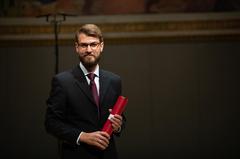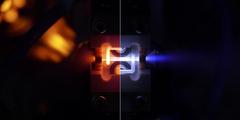URL: https://www.desy.de/news/news_search/index_eng.html
Breadcrumb Navigation
DESY News: His Majesty the King's Gold Medal for Carl Lindstrøm
News
News from the DESY research centre
His Majesty the King's Gold Medal for Carl Lindstrøm
DESY scientist Carl Andreas Lindstrøm has been awarded the Gold Medal of His Majesty the Norwegian King Harald V for outstanding young researchers from the University of Oslo. The Norwegian scientist, who is today working at DESY on future linear accelerators, was honoured for his doctoral thesis about future particle accelerators. This includes the discovery of an innovative plasma lens for focussing particle beams and studies of the acceleration of positrons in a hollow plasma channel.

Carl Andreas Lindstrøm at the award ceremony in Oslo. Credit: UiO/Jarli&Jordan
At the European particle research lab CERN, a team from Oslo, the University of Oxford, CERN and DESY had investigated plasma lenses that are regarded as a promising alternative to the magnets used today to focus particle beams. In a so-called active plasma lens, a strong electric current passes through the plasma along the path of the particles, creating a magnetic field vortex. In contrast to classical quadrupole magnets, this field can simultaneously focus the height and the width of the particle beam. Along with their high focusing power, due to the strong magnetic fields, this makes such lenses extremely attractive for use in particle accelerators.
However, a key problem had so far prevented such a deployment of plasma lenses: an optical flaw in the lens destroys the focus of the particle beam as it passes through the plasma cell. This so-called aberration occurs because zones of different temperatures form within the plasma when the plasma is heated by the current flowing through it and at the same time cooled by the outer walls of the plasma cell. As a result, the strength of the focussing field varies in different regions of the plasma, leading to the optical flaw in the lens. Until now, this aberration has occurred so quickly after igniting the plasma that it was not possible to use the plasma lens to focus a particle bunch before the lens developed the flaw.

Montage of two photos during the operation of the plasma lens: with helium (red) and argon (blue). Credit: Carl A. Lindstrøm, University of Oslo
“We measured again and again, always with the same result: no distortion,” Lindstrøm recalls. “At first we thought that the other laboratories might have done something wrong, since we used a different method that should be more precise. In the end, we managed to carry out the experiment with helium as well, and then the distortion appeared again. Then we realized that we had stumbled upon something interesting!”
The explanation: The heavier argon slows down the conduction of heat within the gas for long enough to allow a bunch of particles to be focused immediately after the plasma has been formed and the current to the magnet has been switched on, without the quality of the beam suffering as a result. The plasma lens only begins to distort the beam after the bunch has passed through it. In other words, using argon instead of helium eliminated one of the biggest problems with active plasma lenses. Thus, an important component in future accelerators is one step closer, as the team reports in the journal Physical Review Letters.
The concept of active plasma lenses stems from the 1950s and was first conceived for ion beams. In 2015 at the Lawrence Berkeley National Laboratory (LBNL), the team of Wim Leemans, who is today director of DESY's Accelerator Division, re-discovered the concept and was the first to use active plasma lensing for electron beams. This triggered many follow on experiments in labs around the world.
Further reading: Hans Majestet Kongens gullmedalje (in Norwegian)




